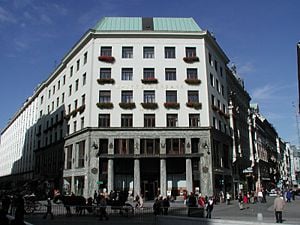Adolf Loos
Adolf Loos (December 10, 1870 in Brno, Moravia–August 8, 1933 in Vienna, Austria) was an early-20th century Viennese architect.
Major works
- Steiner House, Vienna, Austria, 1910
- Looshaus, Vienna, Austria, 1911
- Rufer House, Vienna, Austria, 1922
- A house and studio for Dadaist Tristan Tzara in the Montmartre section of Paris, France, 1926
- Khuner Villa, Kreuzberg, Austria, 1930
- Villa Müller, Prague, Czech Republic, 1930
Architectural work
Loos' work, although varied in style, is most known for a period of houses of highly stereometric form and white color. The exteriors were greatly simplified in ornament. The interiors were, constrastingly, highly complex spatially and materially luxurious.
Ornament and Crime
In addition to his built projects, Loos is noted for his essay/manifesto Ornament and Crime written in 1908, but only published in Western Europe in the late 1920s. This essay is a repudiation of the work of the Vienna Secession, the Austrian version of Art Nouveau. Loos' provocative catch phrase was taken up by the Modern Movement in architecture, one of the other famous catch phrases of which is "form follows function". In the years between 1893 and 1896, Loos lived and worked in United States.In it, he expressed the idea that the progress of culture is associated with the deletion of ornament from everyday objects, and that it was a crime to force craftsmen or builders to waste their time on ornamentation that served to hasten the time when an object was obsolete. Accordingly, the most primitive societies use a lot of decoration and the most advanced societies have no superfluous ornament, or at least there is benefit in suppressing ornamentation which serves no useful purpose. In the same essay Loos asserted that a European man who tattoos himself is either a criminal or a degenerate; if a tattooed man dies out of prison, Loos reasoned, it is only because he did not live long enough to commit his inevitable murder. Such rhetoric is typical of contemporary journalism. In 1898, he wrote a newspaper column on design issues for the Neue Freie Presse, of great interest to Vienna's educated middle classes.
Surprisingly, Loos' own architectural work is often decorative, similar to the prolific fellow Viennese architect (and leader of the Vienna Secession), Otto Wagner. The visual distinction is not between complicated versus plain, but between "organic" and superfluous. American architect Frank Lloyd Wright is a notable example of an advocate of the former, despite some dubious decorative designs among some later projects.
Loos was also interested in the decorative arts, collecting sterling silver and high quality leather goods, which he noted for their plain yet luxurious appeal. He also enjoyed fashion and men's clothing, designing the famed Knize of Vienna, a haberdashery.
Loos is also known for his notorious entry to the 1922 Chicago Tribune competition, which took the form of a single colossal Doric column. His submission could well have been designed during the Post-Modernist period of the 1980s.
External links
- Adolf Loos at the archINFORM database
- Biography and important works
- Biography at WOKA E/D
Credits
New World Encyclopedia writers and editors rewrote and completed the Wikipedia article in accordance with New World Encyclopedia standards. This article abides by terms of the Creative Commons CC-by-sa 3.0 License (CC-by-sa), which may be used and disseminated with proper attribution. Credit is due under the terms of this license that can reference both the New World Encyclopedia contributors and the selfless volunteer contributors of the Wikimedia Foundation. To cite this article click here for a list of acceptable citing formats.The history of earlier contributions by wikipedians is accessible to researchers here:
The history of this article since it was imported to New World Encyclopedia:
Note: Some restrictions may apply to use of individual images which are separately licensed.

